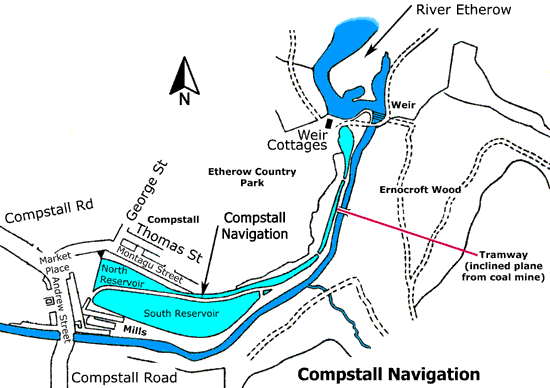
The Cheshire village of Compstall, once known as Compstall Bridge, was made a civil parish in 1897 from part of Werneth and in 1936 this parish was abolished and divided; part going to Hyde and part going to Bredbury and Romiley. It was transferred to Stockport Metropolitan Borough in 1974 when the county of Greater Manchester was established.
In the early 1800s, two brothers, George and Thomas Andrew, established a textile business beside the river Etherow at Compstall Bridge, close to its confluence with the river Goyt. Initially, the business only dyed and printed cotton but in 1824 it was expanded by the introduction of cotton spinning and weaving.
The Andrew family were actively involved in business at Compstall Bridge and in Pigot's Commercial Directory of Derbyshire for 1835 there were four entries:
Gentry & Clergy:Andrew George, Esq. Green Hill, Compstall Bridge.Calico Printers:Andrew Edward & James, Compstall Bridge.Coal Merchants:Andrew George, Compstall Bridge.Cotton Spinners:Andrew, Bruckshaw & Co. (manufacturers by power), Compstall Bridge.
Curiously, there was no mention of Thomas Andrew in the directory. The family surname was commemorated by naming a short section of the main road through the village, Andrew Street, and this runs from Market Place down to the bridge over the river Etherow. The family mills are on the eastern side of this street. George, Thomas and Edward are also commemorated with nearby street names.

To begin with, waterwheels using water from the river Etherow powered the mills and about 1,200 yards above them a substantial weir was built across the river to impound water for this purpose. It was the usual practice to channel water from weirs along millraces (or mill lades) to supply waterwheels but in this instance two reservoirs were built and the northern one was constructed as a short navigable canal (Compstall Navigation) and water was supplied to the upper end of this from the Etherow. It was cut alongside the river and it terminated at a point adjoining the mills and a sluice arrangement was provided to admit water to the southern reservoir, which adjoined the mills.
It is recorded that in 1833 two steam engines were in use at the mills, each of 45 horsepower. Furthermore, by 1834 the mills were lit by coal gas lamps, the gas being produced on site. Consequently, the directory entry for 1835 emphasises that they were manufacturing with power. The family wished to make it known that their mills were then powered by steam engines. It is unclear whether the introduction of this second power source replaced water power or accompanied it.
There was an abundant supply of easily mined coal in the vicinity and in particular there was a good outcrop in Ernocroft Wood situated on the steep valley side to the south east of the Etherow. Consequently, a coal mine was established in the wood and from this a tramway was built down the valley side and across the Etherow to terminate at a coal staithe built at the side of the canal. The double-tracked tramway was in the form of a self-acting inclined plane whereby waggons loaded with coal descending the plane were used to haul empty waggons back up to the coal mine. The river crossing was on a wooden trestle bridge with stone abutments. The abutments were over 18 feet wide and they were battered in order to withstand earth pressure from the valley side and floods in the river. At the staithe, waggons were emptied into tub boats, which were then hauled by horses the short distance to the mills.
The tub boats were 22 feet 6½ inches long by 6 feet 5 inches wide at the gunnels and at the bottom of the hold they were 18 feet 10 inches long, the vertical sides being 3 feet 2½ inches high. They were constructed of wrought-iron plates riveted together and towing rings were attached to the gunnels. There were also four rowlocks, used for steering purposes, as there was no rudder. It is estimated that a fully laden tub boat could carry 8 tons of coal. Tub boats were hauled by horses and it is understood that they were arranged in trains of three.
In 1828, George Andrew leased the right to mine coal in Ernocroft Wood from the Duke of Norfolk who owned the Manor of Glossop of which Compstall Bridge was then part. The lease was for 20 years and it stipulated that the Duke was to be paid an annual sum amounting to ? of the selling price of the coal extracted or a minimum of £10, whichever was the greater. The accounts for the Duke's Glossop estate show that he was paid between £33 and £42 per annum from this source and it is likely that most of the coal mined in Ernocroft Wood was consumed in the mills. Nevertheless, in the 1820s and in 1835 George Andrew was listed in trade directories as a coal merchant so he was also selling coal locally.
When the lease expired in 1848 it is uncertain whether or not it was renewed but the indications are that the mine closed around this time. By the 1860s the family's mining interests seemed to have moved upriver, beyond the weir, to an area known as 'The Keg'.
It is not known with any certainty when the Compstall Navigation ceased being used as a canal, except that it was somewhere between 1848 and the 1860s. Today, the Compstall Navigation is within the Etherow Country Park which also incorporates the Compstall Nature Reserve.
Click thumbnails for full pictures, then click browser back button/arrow to return here